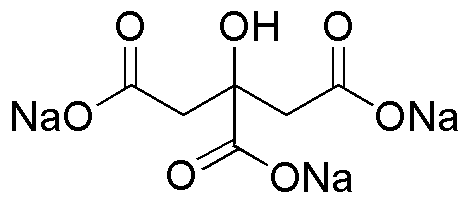Citric acid trisodium salt anhydrous is widely utilized in research focused on:
- Food Industry: It serves as a flavoring agent and preservative, enhancing the taste of various products while extending shelf life.
- Pharmaceuticals: Used as a buffering agent in medications, it helps maintain pH levels, ensuring the stability and effectiveness of active ingredients.
- Cosmetics: Commonly found in skincare products, it acts as a pH adjuster and stabilizer, improving product performance and skin compatibility.
- Cleaning Products: Its chelating properties make it effective in removing hard water stains and enhancing the cleaning power of detergents.
- Biotechnology: Employed in laboratory settings for cell culture media, it supports cell growth and metabolism, crucial for research and development.
General Information
Properties
Safety and Regulations
Applications
Citric acid trisodium salt anhydrous is widely utilized in research focused on:
- Food Industry: It serves as a flavoring agent and preservative, enhancing the taste of various products while extending shelf life.
- Pharmaceuticals: Used as a buffering agent in medications, it helps maintain pH levels, ensuring the stability and effectiveness of active ingredients.
- Cosmetics: Commonly found in skincare products, it acts as a pH adjuster and stabilizer, improving product performance and skin compatibility.
- Cleaning Products: Its chelating properties make it effective in removing hard water stains and enhancing the cleaning power of detergents.
- Biotechnology: Employed in laboratory settings for cell culture media, it supports cell growth and metabolism, crucial for research and development.
Documents
Safety Data Sheets (SDS)
The SDS provides comprehensive safety information on handling, storage, and disposal of the product.
Product Specification (PS)
The PS provides a comprehensive breakdown of the product’s properties, including chemical composition, physical state, purity, and storage requirements. It also details acceptable quality ranges and the product's intended applications.
Certificates of Analysis (COA)
Search for Certificates of Analysis (COA) by entering the products Lot Number. Lot and Batch Numbers can be found on a product’s label following the words ‘Lot’ or ‘Batch’.
*Catalog Number
*Lot Number
Certificates Of Origin (COO)
This COO confirms the country where the product was manufactured, and also details the materials and components used in it and whether it is derived from natural, synthetic, or other specific sources. This certificate may be required for customs, trade, and regulatory compliance.
*Catalog Number
*Lot Number
Safety Data Sheets (SDS)
The SDS provides comprehensive safety information on handling, storage, and disposal of the product.
DownloadProduct Specification (PS)
The PS provides a comprehensive breakdown of the product’s properties, including chemical composition, physical state, purity, and storage requirements. It also details acceptable quality ranges and the product's intended applications.
DownloadCertificates of Analysis (COA)
Search for Certificates of Analysis (COA) by entering the products Lot Number. Lot and Batch Numbers can be found on a product’s label following the words ‘Lot’ or ‘Batch’.
*Catalog Number
*Lot Number
Certificates Of Origin (COO)
This COO confirms the country where the product was manufactured, and also details the materials and components used in it and whether it is derived from natural, synthetic, or other specific sources. This certificate may be required for customs, trade, and regulatory compliance.

